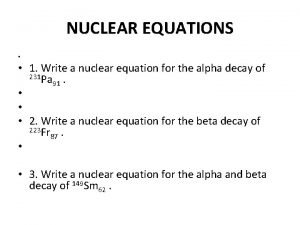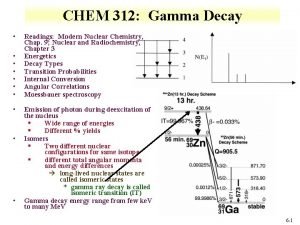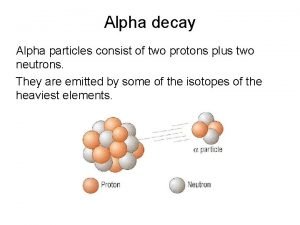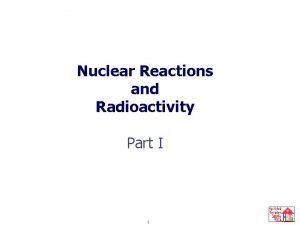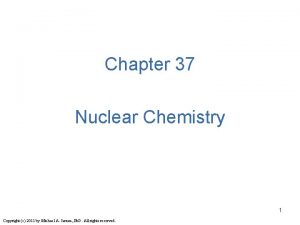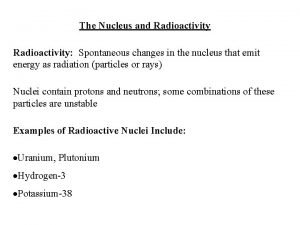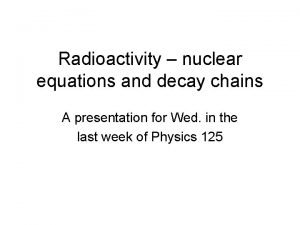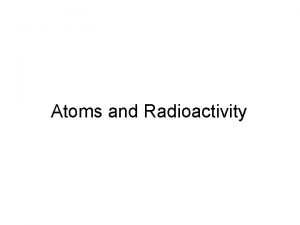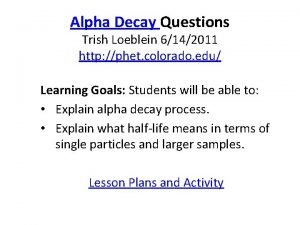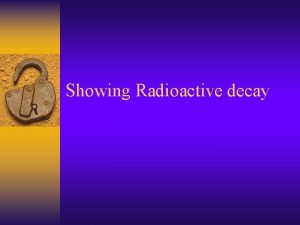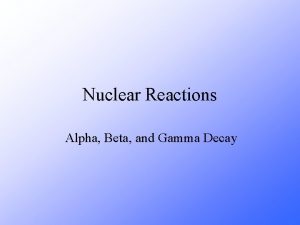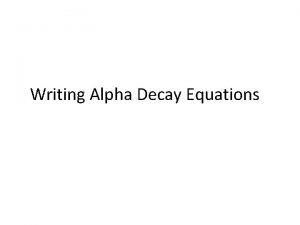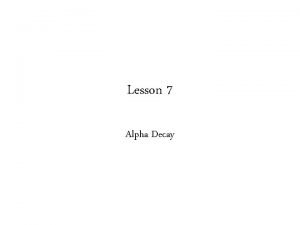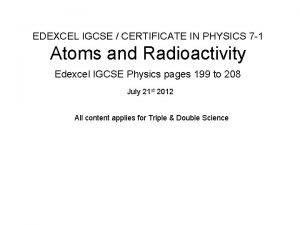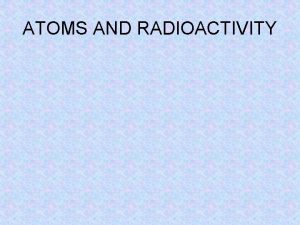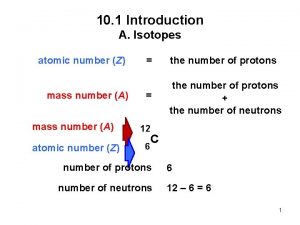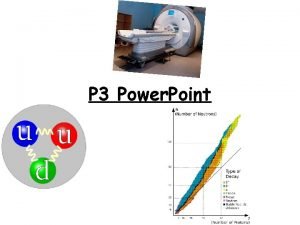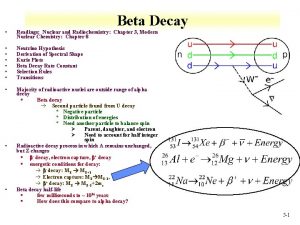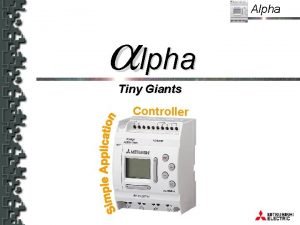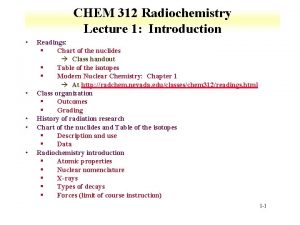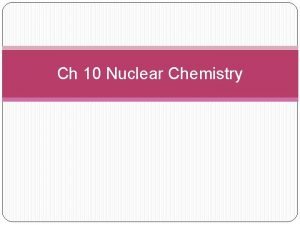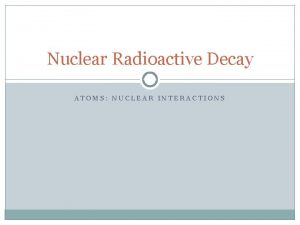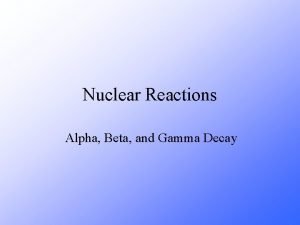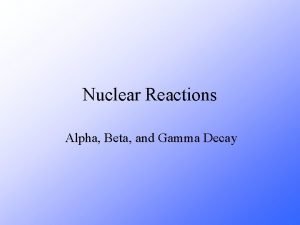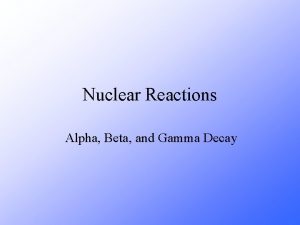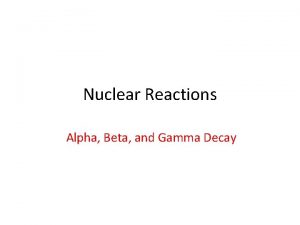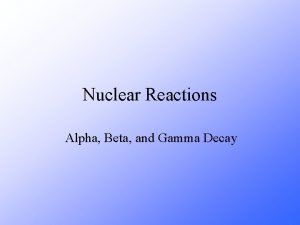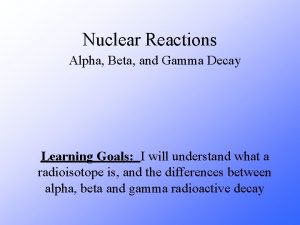Alpha Decay Readings Nuclear and Radiochemistry Chapter 3






















- Slides: 22

Alpha Decay • • Readings § Nuclear and Radiochemistry: Chapter 3 § Modern Nuclear Chemistry: Chapter 7 Energetics of Alpha Decay Theory of Alpha Decay Hindrance Factors Heavy Particle Radioactivity Proton Radioactivity Identified at positively charged particle by Rutherford § Helium nucleus (4 He 2+) based on observed emission bands § Energetics à Alpha decay energies 4 -9 Me. V à Originally thought to be monoenergetic, fine structure discovered AZ (A-4)(Z-2) + 4 He + Q 1

Fine Structure and Energetics • Different alpha decay energies for same isotope § Relative intensities vary and coupled with gamma decay • Over 350 alpha emitting nuclei § Alpha energy used to develop decay schemes • All nuclei with mass A > 150 are thermodynamically unstable against alpha emission § Qα is positive • However alpha emission generally seen for heaviest nuclei, A≥ 210 § Energy ranges 1. 8 Me. V (144 Nd) to 11. 6 Me. V (212 m. Po) Alpha decay observed for à half-life of 144 Nd is negative binding energies 5 x 1029 times longer then 212 m. Po 2

Energetics • • • Q values generally increase with A § variation due to shell effects can impact trend increase § Peaks at N=126 shell For isotopes decay energy generally decreases with increasing mass 82 neutron closed shell in rare earth region § increase in Qα § α-decay for nuclei with N=84 as it decays to N=82 daughter short-lived α-emitters near doubly magic 100 Sn § 107 Te, 108 Te, 111 Xe alpha emitters have been identified by proton dripline above A=100 3

Alpha Decay Energetics • Q value positive for alpha decay § Q value exceeds alpha decay energy § m T = m d T d § md and Td represent daughter • From semiempirical mass equation § emission of an α-particle lowers Coulomb energy of nucleus § increases stability of heavy nuclei while not affecting overall binding energy per nucleon à tightly bound α-particle has approximately same binding energy/nucleon as original nucleus * Emitted particle must have reasonable energy/nucleon * Energetic reason for alpha rather than proton • Energies of alpha particles generally increase with atomic number of parent 4

Energetics • Calculation of Q value from mass excess § 238 U 234 Th + + Q à Isotope Δ (Me. V) 238 U 47. 3070 234 Th 40. 612 4 He 2. 4249 § Q =47. 3070 – (40. 612 + 2. 4249) = 4. 270 Me. V § Q energy divided between α particle and heavy recoiling daughter à kinetic energy of alpha particle will be slightly less than Q value • Conservation of momentum in decay, daughter and alpha are equal rd=r § recoil momentum and -particle momentum are equal in magnitude and opposite in direction § p 2=2 m. T where m= mass and T=kinetic energy • 238 U alpha decay energy 5

Energetics • Kinetic energy of emitted particle is less than Coulomb barrier α -particle and daughter nucleus § Equation specific of alpha § Particles touching § For 238 U decay • Alpha decay energies are small compared to required energy for reverse reaction • Alpha particle carries as much energy as possible from Q value, • For even-even nuclei, alpha decay leads to ground state of daughter nucleus § as little angular momentum as possible § ground state spins of even-even parents, daughters and alpha particle are l=0 6

• • • Some decays of odd-A nuclei populate daughter excited states with spin of parent § Leads to alpha fine structure Orbital angular momentum of α particle can be zero § 83% of alpha decay of 249 Cf goes to 9 th excited state of 245 Cm à lowest lying state with parent spin and parity Long range alpha decay § Decay from excited state of parent nucleus to ground state of daughter § 212 m. Po à 2. 922 Me. V above 212 Po ground state à Decays to ground state of 208 Pb * 11. 65 Me. V alpha particle Systematics from § Coulomb potential à Higher mass accelerates products § larger mass à daughter and alpha particle start further apart mass parabolas from semiempirical mass equation § cut through nuclear mass surface at constant A § Explains beta decay in decay chain Energetics Beta Decay to Energy minimum, then Alpha decay to different A Branched Decay 7

• • Distance of closest approach for scattering of a 4. 2 Me. V alpha particle is ~62 fm § Distance at which alpha particle stops moving towards daughter § Repulsion from Coulomb barrier Alpha particle should not get near nucleus § should be trapped behind a potential energy barrier Wave functions are only completely confined by infinitely highpotential energy barriers § With finite size barrier wave function has different behavior § main component inside barrier § finite piece outside barrier Tunneling § trapped particle has component of wave function outside potential barrier § Some probability to go through barrier à Related to decay probability § Higher energy has higher tunneling probability Alpha decay theory Vc Alpha decay energy 8

Alpha Decay Theory • • Closer particle energy to barrier maximum more likely particle will penetrate barrier More energetic alpha will encounter barrier more often § • Increase probability of barrier penetration due Geiger Nuttall law of alpha decay § • constants A and B have Z dependence. simple relationship describes data on α-decay § over 20 orders of magnitude in decay constant or half-life § 1 Me. V change in -decay energy results in a change of 105 in half-life 9

Expanded Alpha Half Life Calculation • More accurate models of half life are possible § Example from Hatsukawa, Nakahara and Hoffman Outside of closed shells 78 Z 82; 100 N 126 82 Z 90; 100 N 126 • Theoretical description of alpha emission based on calculating rate in terms of two factors § rate at which an alpha particle appears at inside wall of nucleus § probability that alpha particle tunnels through barrier • =P*f à f is frequency factor 10 à P is transmission coefficient

Alpha Decay Theory • • • Now have additional factor that describes probability of preformation of alpha particle inside parent nucleus prior to decay No clear way to calculate preformation probability § empirical estimates have been made § theoretical estimates of emission rates are higher than observed rates à uncertainties in theoretical estimates contribute to differences § preformation factor can be estimated for each measured case Evaluation of frequency for alpha particle to reach edge of a nucleus § estimated as velocity divided by distance across nucleus à twice radius, on order of fm à lower limit for velocity obtained from kinetic energy of emitted alpha particle * Use this to determine velocity of alpha particle in nucleus à particle is moving inside a potential energy well and its velocity should be larger and correspond to well depth plus external energy § On order of 1021 s-1 Reduced mass 11

Alpha Decay Calculations • Alpha particle barrier penetration from Gamow § T=e-2 G • Determination of decay constant from potential information • Using square-well potential, integrating and substituting § Z daughter, z alpha 12

Gamow calculations • From Gamow • Calculated emission rate typically one order of magnitude larger than observed rate § observed half-lives are longer than predicted § Observation suggest a route to evaluate alpha particle pre-formation factor 13

Alpha Decay • Even-even nuclei undergoing l=0 decay Theory § average preformation factor is ~ 10 -2 § neglects effects of angular momentum à Assumes α-particle carries off no orbital angular momentum (ℓ = 0) § If α decay takes place to or from excited state some angular momentum may be carried off by α-particle § Results in change in decay constant when compared to calculated 14

Hindered -Decay • Previous derivation only holds for even-even nuclei § odd-odd, even-odd, and odd-even nuclei have longer half-lives than predicted due to hindrance factors • Assumes existence of pre-formed -particles § Ground-state transition from nucleus containing odd nucleon in highest filled state can take place only if that nucleon becomes part of -particle à therefore another nucleon pair is broken àless favorable situation than formation of an -particle from already existing pairs in an even-even nucleus * may give rise to observed hindrance § -particle is assembled from existing pairs in such a nucleus, product nucleus will be in an excited state àthis may explain higher probability transitions to excited states • Hindrance from difference between calculation and measured half-life § Hindrance factors between 1 and 3 E 4 § Hindrance factors determine by àratio of measured alpha decay half life over calculated alpha decay half life àratio of calculated alpha decay constant over measured alpha decay constant 15

• Hindrance Factors Transition of 241 Am (5/2 -) to 237 Np § states of 237 Np (5/2+) ground state and (7/2+) 1 st excited state have hindrance factors of about 500 (red circle) § Main transition to 60 ke. V above ground state is 5/2 -, almost unhindered 16

Hindrance Factors • 5 classes of hindrance factors based on hindrance values • hindrance factors increase with increasing change in spin § Parity change also increases hindrance factor • Between 1 and 4, transition is called a “favored” § emitted alpha particle is assembled from two low lying pairs of nucleons in parent nucleus, leaving odd nucleon in its initial orbital • Hindrance factor of 4 -10 indicates a mixing or favorable overlap between initial and final nuclear states involved in transition • Factors of 10 -100 indicate that spin projections of initial and final states are parallel, but wave function overlap is not favorable • Factors of 100 -1000 indicate transitions with a change in parity but with projections of initial and final states being parallel • Hindrance factors of >1000 indicate that transition involves a 17 parity change and a spin flip

Heavy Particle Decay • • Possible to calculate Q values for emission of heavier nuclei § Is energetically possible for a large range of heavy nuclei to emit other light nuclei. Q-values for carbon ion emission by a large range of nuclei § calculated with smooth liquid drop mass equation without shell corrections Decay to doubly magic 208 Pb from 220 Ra for 12 C emission § Actually found 14 C from 222, 223 Ra § large neutron excess favors emission of neutron-rich light products § emission probability is much smaller than alpha decay simple barrier penetration estimate can be attributed to very small probability to preform 14 C residue inside heavy nucleus 18

Proton Decay • For proton-rich nuclei, Q value for proton emission can be positive § Line where Qp is positive, proton drip line § Describes forces holding nuclei together • Similar theory to alpha decay § no preformation factor for proton § proton energies, even for heavier nuclei, are low (Ep~1 to 2 Me. V) • barriers are large (80 fm) § Long half life 19

Topic Review • Understand utilize systematics and energetics involved in alpha decay • Calculate Q values for alpha decay § Relate to alpha energy and fine structure • Correlate Q value and half-life • Models for alpha decay constant § Tunneling and potentials • Hindered of alpha decay • Understand proton and other charged particle emission 20

Homework Questions • Calculate alpha decay Q value and Coulomb barrier potential for following, compare values § 212 Bi, 210 Po, 238 Pu, 239 Pu, 240 Am, 241 Am • What is basis for daughter recoil during alpha decay? • What is relationship between Qa and alpha decay energy (Ta) • What are some general trends observed in alpha decay? • Compare calculated and experimental alpha decay half life for following isotopes § 238 Pu, 239 Pu, 241 Pu, 245 Pu § Determine hindrance values for odd A Pu isotopes above • What are hindrance factor trends? • How would one predict half-life of an alpha decay from experimental data? 21

Pop Quiz • • • Calculate alpha decay energy for 252 Cf and 254 Cf from mass excess data below. Which is expected to have shorter alpha decay half-life and why? Calculate alpha decay half-life for 252 Cf and 254 Cf from data below. (use % alpha decay) Provide response in blog Have pop quiz ready by 24 September 22
 Nuclear equation solver
Nuclear equation solver Decay factor and decay rate
Decay factor and decay rate Zeta phi beta boule 2022 philadelphia
Zeta phi beta boule 2022 philadelphia Beta decay equation
Beta decay equation Pi eta omega
Pi eta omega Decay nuclear
Decay nuclear U238 alpha decay
U238 alpha decay Gamma decay nuclear equation
Gamma decay nuclear equation Gamma decay nuclear equation
Gamma decay nuclear equation Cobalt 60 nuclear equation
Cobalt 60 nuclear equation Alpha decay of polonium 210
Alpha decay of polonium 210 Gamma emission equation
Gamma emission equation Phet alpha decay
Phet alpha decay Number
Number Axz atom
Axz atom Alpha decay equation
Alpha decay equation Alpha decay
Alpha decay Uranium 238 alpha decay equation
Uranium 238 alpha decay equation Uranium 238 alpha decay equation
Uranium 238 alpha decay equation Write the alpha decay equation for the following isotope:
Write the alpha decay equation for the following isotope: Alpha decay
Alpha decay Aplha decay
Aplha decay Lesson 15 nuclear quest nuclear reactions
Lesson 15 nuclear quest nuclear reactions
